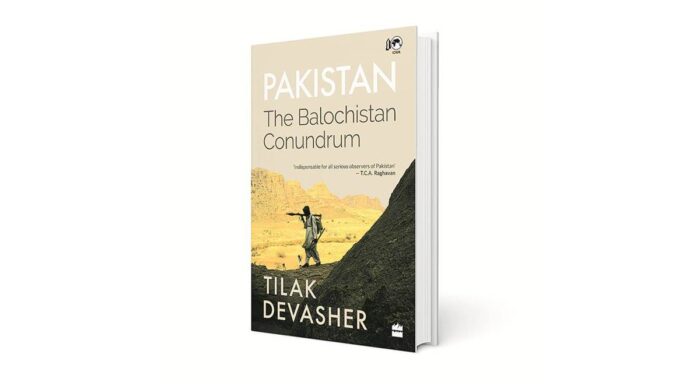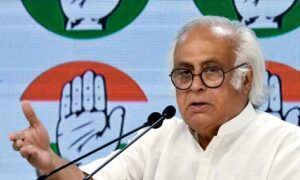
The very title of Tilak Devasher’s well researched study – Pakistan Balochistan conundrum suggests that Balochistan is at once a riddle and a hard, unresolved question for Pakistan right from its birth as a Muslim state- the promised home land of the Muslims of undivided India. The book has five sections , the first two provide a comprehensive account of complex history of this ancient, vast land of diverse people till 1947, its unique land scape- an extension of the Iranian plateau and desert, arid plains and mountains separating Indus valley and Afghanistan.
The next two parts contain an in-depth analysis of the roots of Baloch alienation resulting in what Devasher calls ‘ enduring insurrection”; and finally his conclusion why no resolution of the Baloch Pakistan conflict could be possible within the present Punjabi dominated Pakistani power structure determined to perpetuate a military dominated system in Balochistan with the sole of exploitation of Balochistan’s vast and untapped strategic minerals – coal,gold, oil and gas to benefit mainly Punjab.
The author viewed China Pakistan Economic Corridor – CPEC as manifestation of this exploitative Pakistani approach to Balochistan and no resolution of the conflict,he thinks would be possible. The author cited irrefutable evidence to support the contention of the Baloch separatists that Punjabi Fascism dominating Pakistan would allow no scope for peaceful resolution of the Baloch aspirations.
The author has reiterated the perception that the Baloch tribes despite their diverse ethnic and linguistic characteristics constitute” a land bridge between the Indian and Mesopotamian civilisations”and are in all respects distinct from the settled groups of Indus and Indo Gangetic valley. Geographically, Balochistan has more in common with the Iranian plateau, high lands of Afghanistan or deserts of middle East which explains the fact that Baloch tribes appear to be an ethnic mix of races found in these regions. Geography also restricted trade and cultural contact with the Societies of the Indo Gangetic or the Indus valley.
The author thus concluded in the very first part that Balochistan was not a natural part of India nor integral to any India based Central authority till the British in the early to Mid19 th century established their authority in Delhi and later Punjab following the Treaty of Amritsar in 1848.This vastly enhanced the strategic importance of Balochistan as the gateway to Afghanistan became pronounced when the ” Great game” began with the Tsarist Russia’s bid to gain a foot hold in Afghanistan as the first step to gain access to the Persian Gulf. The British considered the Russian moves as serious threat to their power in India. This made control over the passes to Afghanistan in the North West Frontier which included parts of Baloch inhabited lands critical for securing British strategic interests especially after the British victory in the Second Anglo-Afghan war (1878-80) .
Earlier under the terms of the 1876 Treaty with the -the Khanates and Sardars (Baloch tribal chiefs) the British recognized the independent political identity of the Baloch people while securing under lease agreement the authority to set military infrastructure at Quetta and other locations including construction of the strategic Rail- Road links which made large parts of Balochistan integral to the British North Western Frontier defense structure. This was a turning point in the history of the Baloch people as it created several administrative entities viz the British Balochistan, a Khanate of Kalat and areas under Baloch tribal chiefs functioning under the overall British hegemony. Earlier in 1829, the British “gifted”to Iran as the author put it roughly one fourth of Baloch inhabited areas to win Iran’s support in the ” Great game”and some other Baloch areas to Afghanistan when the boundaries between the British India and Afghanistan were laid down in 1894 under what came to be known as the Durrand Line. All these made the Baloch “a scattered people” in three countries even when the largest segment and the territory remained in British India. It was indeed a ” Buffer State” and therefore the ” independent” character of the Khanates and self-rule of the tribal Sardars were compulsions for the British, Devasher explained to operationalize the concept of the ” frontier of separation” propounded by the British for ” exercise of power within the boundaries of Administration and within boundaries of influence.” This transformed British Balochistan into a” Garrison State”and together with the areas under the Khanates and the Sardars formed 44% of territory of Pakistan and 760 km- two thirds of its Sea coast , 90% of its minerals- coal,gold,oil and gas with only about 6% of estimated 207.687million population of Pakistan. (2017).
The author organised this backdrop with meticulous details to prepare the reader to note the strange approach of the Congress leadership during 1946-47 to Khan of Kalat and Baloch tribes’ demand for restoration of their Independence and reversion of British Balochistan including the ” leased lands” after the British withdrawal. The Congress stand was totally cool and unhelpful to the Baloch demand as Pandit Nehru ruled out the” independent status of Kalat” ignoring the fact that it was implicit in the Treaty relationships with the Crown; and Maulana Azad found Balochistan’s Independence unpracticable even when he conceded that their demands were” genuine”. This gives credence to the view of Congress “complicity” in Partition and hence staunch opposition to the Baloch demand as that would negate the very basis of Pakistan. The Baloch leaders’ offer to join India was spurned even when there was clear sea link with India. Was East Pakistan contiguous to west Pakistan ? was the question the Baloch leaders asked the Congress leadership to which obviously there was no answer . This opportunistic stand of Congress leadership allowed the British to gift both British Balochistan and North West Frontier Province to Pakistan through sham Referendum and also Sylhet in Assam by the same means. The Premier of NWFP Dr. Khan Sahib’s well documented work ” Facts are facts” would give the reader an idea of how the British played their cards so well to create Pakistan. All these, the author concludes facilitated the ” British masterminding role” that enabled Pakistan to swiftly move its Army to occupy Kalat, the main Khanate on 27 March 1949 despite the fact that Pakistan had a”Stand still” Agreement with Kalat like the one it had with Kashmir and violated also in the same manner. The Khan of Kalat surrendered and signed the instrument of accession on March 30,1948 ending ” 227 day Independence of the Kalat Confederacy” formed almost 300 years ago.
The author has rendered a great service to us by giving a blow by blow account how Baloch people lost their Independence mainly due to the British perfidy designed to create a pliable Pakistan ready to serve the western strategic interest in the region close to the Soviet Union. These facts are not known to very many Indians obsessed as they were always with Kashmir. If Balochistan remained independent it would have crippled Pakistan at birth by denying it it’s strategic depth, minerals and more importantly buried the idea of Pakistan. This development would have also produced soon enough an independent Pashtunistan.
It was however not a smooth transition for Pakistan as Baloch insurgency began in 1948 itself and is continuing till date for reasons which are not hard to see- a basic ethno lingual and cultural difference between the Punjabi dominated Pakistani State especially after secession of Bangladesh and the Baloch identity as a separate Nation and a State of their own which they had long before the idea of Pakistan was formulated. The author has detailed five post Accession insurgencies in 1948,1958, 1962 and 1973-77 and the circumstances which led to the same with such regularity and held the authoritarian Pakistani State- which for most of these periods were under military rule solely responsible for alienating the Baloch people and their high handed actions.
In part 3 Devasher examined the roots of Baloch alienation and established with irrefutable evidence that systematic marginalisation of the Baloch people in all spheres of Administration and system of governance especially in the armed forces management of the economy, plunder of natural resources have turned turned Balochistan into a Garrison state with features of the “colonial extractive state” designed to benefit Punjab mainly. Continuing gross violation of human rights facilitated by a pliable judiciary and a military dominated Civil administration reduced the Baloch to subjects of what Baloch leaders’ call a Punjabi Fascist state.
Chapters 9 and 10 on Economic exploitation and socio economic deprivation contain telling evidence how the wealth of Balochistan from oil,gas,coal, gold and copper was ” drained” to enrich mainly Punjab and other parts of Pakistan without any real benefit to the Baloch people. This is continuing and yet another case of Pak “criminal governance” that allowed as in pre- Bangladesh period “sustained transfer of income to West Pakistan.”
The stakes are indeed high for Pakistan in resource rich Balochistan and this explains “relentless persecution” of the Baloch people the author detailed in later sections. There is one factor the author could have mentioned as a major cause of anarchy in Pakistan, that is, the substitution of the institution of the District officer that the British left behind in Pakistan as in India by District Management Group (DMG)caused subversion of the system of administration of criminal justice and maintenance of public order and thereby enabled the military dominated executive to persecute the Baloch resistance at will . This in practice crippled the civil Police and also the judiciary in the absence of the District Magistrate responsible for governance of the District.
To an Indian reader section 4 covering the Chinese role in Pakistan and especially the CPEC- China Pakistan Economic Corridor would be of special interest as it contains an analysis of the convergence of Chinese and Pakistani geopolitical and economic interests . What is evident is that the CPEC is China’s trump card in Pakistan to gain access to the Persian Gulf through Gawadar Port in Balochistan and a permanent strategic foothold in Pakistan along the Kashgar- Gawadar stretch through the Pak occupied Kashmir (POK) And for Pakistan it serves two objects , first to maintain its occupation of Balochistan and POK and assurance of Chinese support on Kashmir and Afghanistan issues. However, the author’s analysis of the slow progress, high security risks due to continuing Baloch insurgency and low return on investment might as well upset these calculations. China it seems has put all her eggs in one basket, Pakistan, considered the “World’s most dangerous place” in recent past by the London based Economist newsmagazine.
In the last section, the author carried out an in-depth analysis of the Baloch Separatists cause, their moves and capabilities and the response of the Pakistani or rather as he puts it the “Punjabi State”. His conclusion that as of now and given the disposition of the Pak Army in Balochistan ” the conflict is unlikely to threaten the integrity of the state” seems reasonable. Equally valid is the point made by the International Crisis Group (ICG) that the ” insurgency is not likely to recede, nor will Islamabad manage to dampen the Baloch” as quoted by the author despite the movement’s weakness in some respects.
The author has exposed the autocratic and ” extractive” character of the Pakistani state which from its very beginning has been necessarily fragile. However unpalatable the fact is that Pakistan has a larger than life image in India despite its fragility nor its” failing state” character which is so apparent.This is mainly because of Kashmir and nuclear power when in reality Pakistan is a backward,demographically challenged state and is among the most backward in the SAARC and ASEAN groups of nations. With a huge population of 207.685 millions and that too growing alarmingly @ 2.4% annually, 38% of the population below the poverty line when 91% of low income families don’t have regular source of income and only 58.92% Adult literacy, Pakistan is a development economist’s nightmare.Ahmed Rashid in his” Pakistan on the brink” has bluntly put it in the following words:
Pakistan’s new global identity was not as a model of innovation or modernity but as a refuge for multiple extremist groups”.(page 46).
The hard reality is that none of its units other than Punjab such as Sind or Khyber Pakhtuniya had ever a real stake in Pakistan as everything came under Punjabi control since the Military take over in1958. Worse still is the fate of the “Muhajirs”- Muslim migrants from India who are treated as second class citizens and who have been struggling for a space in the state. Even then the actions of the Punjabi State in Balochistan and Sind suggest that Punjab also suffers from a deep sense of insecurity of being ” landlocked”; because geopolitics and history remind us that power based in a land locked region usually have adversarial relations with Coastal Region. Therefore statesmanship demands amicable relationships between the regions. Pakistan is doing just the opposite of what is prudent to sustain the state by suppressing the legitimate aspirations of the Baloch and the Sindhi people of the coastal region.
The author’s conclusion that a just solution to the Balochistan conundrum is “a solution that puts the Baloch in the center rather than the resources of the province”; and that” failure to do so will slowly but inexorably exacerbate the crisis in Balochistan till it explodes with dire consequences for Pakistan” is prescient.
There is an unstated message here for India also. Baloch insurgency and the secession of East Pakistan earlier demonstrate that religion as a force unifying diverse groups has its limitations as beyond a point facts like gross regional imbalance in development, perceived economic exploitation and political marginalisation create separate national identities founded on the rejection of the idea that created the nation state in the first place. Insurgency is the violent expression of such a break away identity assertion. Geography is not just the” economic destiny of a nation”(2006 Strategy Report of the World Bank on NE India) it also shapes formation of political identities especially in countries which have a long coast line as we see in Scotland now which was unthinkable only some years ago.
In the end one must note the remarkable objectivity of the author, his facile pen ; and despite the fact that he had first hand knowledge of Pakistan he abstained from making anecdotal references- so distressingly common in the writings of retired officials and especially diplomats. The references cited in the Notes section of 54 pages bear testimony of the author’s painstaking research and hard work. This is indeed a must read book for any one keen to know about Balochistan and Afghanistan- Pakistan Region.
[the_ad id=”22718″]


















